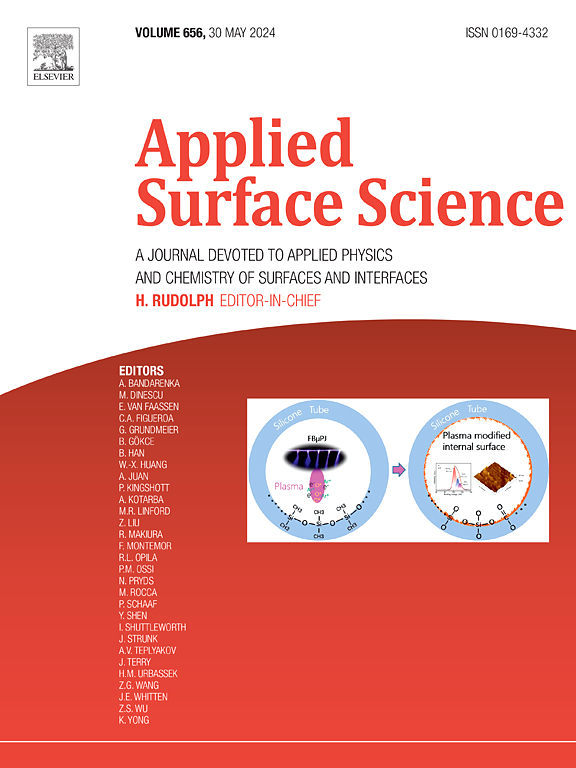Efficient flotation of sodium lauroyl sarcosinate on Pb2+-modified rutile surface: experimental study and DFT calculation
IF 6.3
2区 材料科学
Q2 CHEMISTRY, PHYSICAL
引用次数: 0
Abstract
This work explored the application of sodium lauroyl sarcosinate (SLAS) as a green surfactant in rutile flotation systems. A detailed examination of the flotation behavior and adsorption characteristics of rutile was conducted, particularly under Pb2+ ion-modified conditions. The experimental methodology incorporated multiple analytical techniques: micro-flotation experiments, surface potential analysis, adsorption quantification, FTIR spectroscopy, SEM-EDS characterization, XPS surface analysis, and computational DFT simulations. Micro-flotation experiments demonstrated that under the optimal conditions (SLAS concentration of 2.8 × 10−4 mol/L, pH 3), a rutile recovery of 81.49% was obtained. Notably, as the pH increased, the recovery of rutile exhibited a decreasing trend. Following Pb2+ modification (8.0 × 10−5 mol/L) combined with SLAS treatment (2.8 × 10−4 mol/L), the rutile demonstrated consistent flotation recovery exceeding 90.02% across a broad pH range (3∼7). The adsorption capacity experiments and SEM-EDS results indicated that multiple SLAS layers were adsorbed on the rutile. Moreover, Pb2+ modification improved the favorability of SLAS adsorption. A combination of surface potential measurements and infrared spectroscopy confirmed the chemical adsorption mechanism of SLAS on positively charged rutile surface atoms. XPS characterization confirmed that the SLAS oxygen atoms chemically bonded with the rutile surface Ti/Pb atoms. DFT simulations demonstrated that the adsorption processes were spontaneous, with Pb2+ and SLAS respectively, forming O−Pb and Ti−O bonds on the (110) surface. This mechanism explains how Pb2+ enhances the SLAS adsorption capacity and subsequent flotation efficiency of the rutile. These studies proved the industrial potential of environmentally friendly collector SLAS in rutile flotation.


Pb2+改性金红石表面高效浮选月桂醇肌酸钠的实验研究及DFT计算
这项研究探索了月桂酰肌氨酸钠(SLAS)作为绿色表面活性剂在金红石浮选系统中的应用。对金红石的浮选行为和吸附特性进行了详细研究,尤其是在 Pb2+ 离子修饰条件下。实验方法包含多种分析技术:微浮选实验、表面电位分析、吸附定量、傅立叶变换红外光谱、SEM-EDS 表征、XPS 表面分析和计算 DFT 模拟。微浮选实验表明,在最佳条件下(SLAS 浓度为 2.8 × 10-4 mol/L,pH 值为 3),金红石的回收率为 81.49%。值得注意的是,随着 pH 值的增加,金红石的回收率呈下降趋势。经过 Pb2+ 改性(8.0 × 10-5 mol/L)和 SLAS 处理(2.8 × 10-4 mol/L)后,金红石在广泛的 pH 值范围(3∼7)内表现出一致的浮选回收率,超过 90.02%。吸附容量实验和 SEM-EDS 结果表明,金红石上吸附了多个 SLAS 层。此外,Pb2+ 修饰提高了 SLAS 的吸附能力。表面电位测量和红外光谱相结合,证实了 SLAS 在带正电荷的金红石表面原子上的化学吸附机制。XPS 表征证实,SLAS 的氧原子与金红石表面的 Ti/Pb 原子发生了化学键合。DFT 模拟表明,吸附过程是自发的,Pb2+ 和 SLAS 分别在 (110) 表面形成 O - Pb 和 Ti - O 键。这一机制解释了 Pb2+ 如何增强 SLAS 的吸附能力以及金红石随后的浮选效率。这些研究证明了环保型捕收剂 SLA 在金红石浮选中的工业潜力。
本文章由计算机程序翻译,如有差异,请以英文原文为准。
求助全文
约1分钟内获得全文
求助全文
来源期刊

Applied Surface Science
工程技术-材料科学:膜
CiteScore
12.50
自引率
7.50%
发文量
3393
审稿时长
67 days
期刊介绍:
Applied Surface Science covers topics contributing to a better understanding of surfaces, interfaces, nanostructures and their applications. The journal is concerned with scientific research on the atomic and molecular level of material properties determined with specific surface analytical techniques and/or computational methods, as well as the processing of such structures.
 求助内容:
求助内容: 应助结果提醒方式:
应助结果提醒方式:


